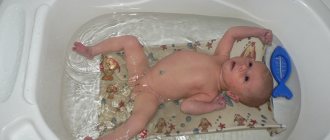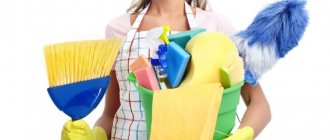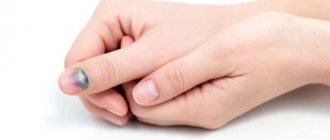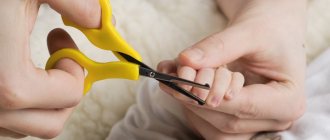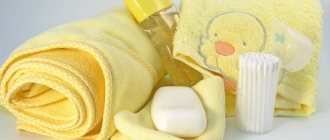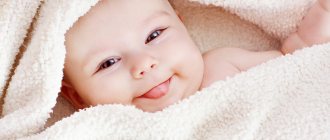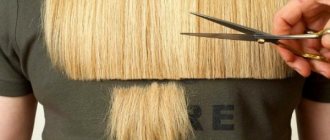Baby's toenails and fingernails grow during prenatal development. It's not surprising that a baby can be born with a decent manicure, and it can also be very sharp. A baby's delicate skin can easily be injured if he scratches himself, so one of the very first questions when caring for a baby is how to cut a newborn's nails.
Trimming nails of a newborn
When should you start cutting your newborn's nails?
Not all new parents know how to cut a newborn’s nails. Most pediatricians recommend starting a week after birth. At birth, the nail plate of all children is soft and flexible; some are born with already quite long nails, while others grow them back during the first days of life.
The recommendation of pediatricians not to do any manicure manipulations for some time after birth is associated with the risk of injuring the child, and thereby introducing any infections. As they grow, brittle nails will break off on their own.
However, there is also no need to wait too long - untimely trimming can lead to an overgrown nail growing into the outer phalanx of the finger, that is, leaving wounds that will be difficult for the baby’s fragile body to cope with. Also, timely trimming of overgrown nails will eliminate the possibility of the nail plate becoming in the wrong position.
If your baby’s nails from the first days of life are long enough to scratch him, you need to purchase “scratchers.” These are small pouch-shaped gloves that fit on a child's hand and prevent the child from scratching himself.
Neurologists do not advise leaving a child in them constantly, especially for a long period of time, since from the first weeks of life the baby develops a grasping reflex. He takes in his hand his parents' fingers and small toys that can fit in his palm.
If you do not cut his nails for a long time and instead constantly put on scratches, the child will not be able to develop these important reflexes in a timely manner, and will not have the opportunity to explore the world around him.
The optimal time for cutting a newborn's nails will be the 2nd week of his life, for example, after his first full bath at home. Until this point, scratches can be used.
A timely procedure carried out in compliance with hygienic rules will not only not harm the child, but will also help in the development of his reflexes.
Dots and mushrooms
Small white dots or longitudinal grooves that appear on the nails are an SOS signal from the body: this means that the baby is lacking vitamins. Which ones exactly should be determined by the pediatrician. After taking the missing substances, the spots usually disappear as soon as a new nail grows.
Serious changes to the nails and the skin around them occur with psoriasis. Pinpoint pits appear, like on a thimble, and the surface becomes rough and pockmarked. Sometimes the nail plate separates from the bed. Often the nails change color (become dull white), configuration, and thicken. Only a dermatologist can determine whether it is psoriasis or a fungus, so do not put off visiting a doctor and do not self-medicate on the advice of grandmothers and friends.
Fortunately, fungal infections of the nail plates in children are rare. However, some caution will not hurt, especially if the child visits the bathhouse or swimming pool. Cracks and wounds on the skin, decreased immunity - and now a fungus multiplies, loving a humid, warm microclimate.
For water procedures, the baby should have special slippers, preferably with thick soles and from which the foot does not hang down. If you still do not rule out the possibility of infection, after the pool, wipe your child’s feet with regular hydrogen peroxide - it will destroy all germs.
To avoid trouble, teach your child to always wear flip-flops, wipe their feet dry after a shower, and never step on a wet floor or stream of dirty water in the shower. When visiting, let the baby wear socks, but you should always refuse other people’s slippers. And strengthen your immune system - a healthy body is not afraid of fungal infections.
How to properly perform a manicure procedure
A newborn's nails grow very quickly; a manicure procedure will need to be done approximately once every 3 days. To do this, you should use special tools and stock up on hydrogen peroxide or chlorhexidine solution. This will help minimize injuries during the process and avoid any possible consequences.
Some parents, despite the existence of special tools, prefer to simply bite off the thin nails of a newborn. It is categorically not recommended to do this, since, in addition to the risk of transmitting microbes from your mouth to your child, the “cut” of the nail turns out to be uneven, and the whole point of the procedure is reduced to a minimum.
How to prepare a place for cutting nails for a newborn
To make your child feel comfortable and not afraid of the procedure, prepare the place and everything necessary for cutting nails in advance.
- It is important to have good lighting . So turn on extra lights or move to a window.
- Place a sterile diaper on the changing table or bed.
- Wash your child's hands with antibacterial soap.
- Treat your hands with an antiseptic solution . This must be a solution that does not contain alcohol. Miramistin is excellent for these purposes.
Place all the equipment necessary for the procedure nearby so as not to be distracted while cutting your nails.
How not to scare your baby
Resourceful parents know how to trim a newborn’s nails without harming him. They advise doing this while he is sleeping.
At this moment, the baby is most calm and will not experience discomfort. The parent needs to grab the child's wrist with such force as to avoid possible sudden movement of the hand, but also not to wake him up with strong pressure. This way, you can expect your baby to stay awake and his nails to be trimmed.
Another suitable time for the procedure may be during feeding. The child will be as relaxed as in sleep, which will make work much easier. A nursing mother alone will not be able to cut his nails at this moment; this will require two adults.
It is very convenient to cut the nails of a newborn baby during nap time
It is better to hold the child's finger between your index finger and thumb. This way you can move the fingertip and securely fix the baby’s hand. This method makes it easier for parents and protects the baby from cuts. Optimal nail shape
The baby's nail should be smooth so as not to leave marks on the skin or cling to tissue. You need to trim the nail by about a millimeter, and in no case to the root. The optimal length is along the line of the fingertip or slightly longer. If after cutting there are sharp corners left, they should be filed using a soft file.
On the hands the nail shape must be oval, and on the feet it must be square. That is, the fingers on the hands need to be cut in a semicircle, but on the feet an even cut is sufficient. This rule will prevent ingrown nails. You can make an even cut only with the help of special tools with well-sharpened blades.
How to grow a child's nails?
If you notice that your son or daughter’s nails are growing poorly, peeling, or breaking, there is a reason to pay attention to the state of his health. This may signal diseases of the immune, cardiovascular, or endocrine systems, or be associated with a lack of vitamins and minerals supplied with food. It's better to see a doctor. Do not try medications or folk remedies on your own based on the search on the Internet “how can a child grow nails quickly.”
If the reason turns out to be a lack of vitamins and minerals, reconsider the baby’s diet. Add more meat, fish, dairy products, green apples, broccoli. These products are rich in calcium, iron, vitamin B7, which is beneficial for the health and growth of nails in children. Perhaps the doctor will prescribe special vitamin and mineral complexes.
Additional information and registration by phone.
What to do if you accidentally hurt your finger
Most parents, at one time or another, have encountered the fact that due to an unsuccessful movement, they injured their baby’s finger during a manicure procedure. There is nothing wrong with this if you follow a number of rules.
The first and basic rule is the sterility of the instruments used for manicure. They must be treated with alcohol before the procedure and be strictly individual for each child. The second rule is to properly treat the cut area.
There is a simple algorithm for this:
- The first step is to apply a sterile material (cotton, cotton pad or bandage) to the wound for a few seconds to provide slight pressure and stop the bleeding.
- Next, when the bleeding stops, you need to treat the cut site with a disinfectant solution. It is better to choose drugs that do not contain alcohol, for example, Chlorhexidine or Furacilin.
- If the wound was deep enough, you can apply a bandage with a healing ointment, for example, Bepanten, to your finger.
Provided that such cuts are repeated infrequently, young children will quickly forget minor painful sensations, and the wound will quickly heal.
First procedure time
Cutting your baby's nails for the first time is always scary; it seems like an incredibly difficult task. A baby that has just been born has thin, small fingers and nails. The latter can break very quickly and are not easy to “pick up” with tweezers or scissors.
Note! Dr. Komarovsky, a Russian pediatrician, warns: even if a baby is swaddled “at the seams,” this does not mean that he cannot injure himself. When his hands are free (during bathing, during a massage, while changing clothes and during morning routines), he may scratch himself.
It is known from history that mothers resorted to an extraordinary method of shortening the nails of a baby who had just been born - they used their teeth. There is nothing surprising in this; it is completely natural in nature.
Usually, the nails are cut for the very first time when the baby is already a month old. Until this time, mothers purchase special mittens (“anti-scratch gloves”) and shirts with “closed handles” for their child.
How to cut nails of newborns
Trimming nails with minimal risk and maximum comfort is possible only with the help of special tools for newborns; they look like an adult manicure set. However, they have a number of significant differences, such as size, handle length and protection from sharp corners.
Manicure set for baby includes:
- baby tongs;
- scissors with rounded edges;
- file with soft coating;
- alcohol solution.
All instruments are smaller in size than their adult counterparts. Nippers should be used for the initial cutting of the required surface of the nail; with the help of scissors, you can adjust the shape of the plate, make it rounded on the hands and straighter on the legs; in addition, such scissors do not have sharp ends.
In order not to injure the nail, it is recommended to use a file no more than 2 times a month to correct the shape.
Preliminary disinfection of instruments should not be neglected. This will protect the child in case of cuts and will destroy germs on tools.
Using an adult manicure set is more likely to harm your baby. Using loose scissors and large pliers can cut, prick or damage your fingers even more seriously.
What to trim
Children rarely lie still during a manicure. They randomly shake their arms and jerk their legs; these movements can easily injure the baby. Let's see what and how to cut a newborn's nails painlessly and comfortably for the child and the mother.
The ideal option is if you buy new special children's rounded scissors or wire cutters. They are absolutely safe for children's fingers, because they are created specifically for newborns.
Some mothers use a nail file to trim their children's nails.
You also need to be careful with a nail file, especially an abrasive one. It is difficult to disinfect, and it is easy to cause injury
As for the nail file, often after treatment with it, fragile nails begin to separate.
Important: be sure to treat instruments with a disinfectant solution before each procedure, especially newly purchased ones or those that you use yourself (but it’s better not to use your own instruments!). Wash your hands well
When starting such a serious procedure, pay attention to the lighting. If there is not enough light, turn on an additional light source or reschedule the procedure for the morning or afternoon
It is better to cut a newborn's nails with special scissors with rounded ends. Thanks to them you will not hurt your delicate fingers
Manicure set for baby. Rules for choosing tools, best manufacturers, prices
The developers of special manicure sets for babies know how to cut a newborn’s nails as often as necessary, and not turn each procedure into torture. You need to cut your nails several times a week, so tools for baby manicure are included in the list of mandatory purchases before the birth of your baby.
The market offers not only ordinary pliers and scissors with rounded edges, but also models with an enlarged handle for ease of use, with a magnifying glass and even with LED lighting. Among all the variety, you need to choose tools that will be easy to use and as safe as possible for the child.
You can buy the whole set, or purchase suitable tools individually. Nippers and scissors should be sharp enough to cut the nail and not tear it off.
The file should be chosen as soft as possible, the coarseness of the spray can be increased as the child grows, and it should be used, especially in the first months of the child’s life, no more than a couple of times a month.
There is no need to rely on the cost of the tool. If possible, before purchasing, you should evaluate the size of the ring on the scissors and the length of the handle on the tongs. They must be suitable for the person who will be performing the manicure procedure, because with an inconvenient tool it is much easier to cut a child.
When choosing the blade size on scissors, it is better to give preference to models with a thinner cutting surface. This will allow you to control the process of cutting your nails.
The main advantage of the set is that by purchasing it, parents can immediately try different tools and decide which is more convenient for them to work with. Also, the kits are usually sold in protective cases for storage. This will help you always keep them at hand and protect you from dust.
Kits often include not only scissors, pliers and a file, but also a soft-bristled brush for cleaning your fingers after filing your nails. It is unlikely to be useful in caring for the nails of a newborn, but you can start using it when the baby grows up.
It is better to choose a manufacturer who also creates other products for newborns.
A wide range of products and tools suggests that the brand has a comprehensive approach to the production of children's goods. The big brands have a certain reputation that they follow, a research base, quality assurance and a wide selection.
| Brand | Product | Price | Advantages and disadvantages |
| Chicco Happy Hands | Manicure set in a case: scissors with safe ends, tongs, children's disposable files, brush | From 899 rub. | The scissors have a protective cap (protection from dirt and dust, an older child will not cut himself). Disposable files included. Suitable for use from the first day of a child's life. |
| Om-Nom-nom | Manicure set: safety scissors, tweezers, file. | From 290 rub. | Suitable size for newborns. Lack of a protective case (they need to be stored in a specially designated place, wrapped in clean clothes). |
| Poma | Children's scissors | From 190 rub. | Convenient ring size, suitable for men's and women's hands. |
| Canpol | Forceps | From 360 rub. | Small work surface with a comfortable wide handle. World manufacturer. |
| Suavinex | Scissors with rounded edges | From 360 rub. | The blade size is suitable for cutting nails from the first days of life. Includes protective case. |
| Chicco | Scissors for children's manicure | From 290 rub. | Suitable from birth. European CE certificate of conformity. |
| American Red Cross | Nail clippers with magnifying glass | From 199 rub. | The magnifying glass at the base of the blade helps you better control the nail cutting process. Can only be purchased in online stores. |
If, after purchasing a manicure accessory, parents realize that this particular product is inconvenient for them to use, then it is better to put it aside for the future and buy another one. This will help you feel more comfortable, and will protect your baby from possible cuts.
What to do if there is blood on your finger?
No mother would want to intentionally hurt her beloved child. But often this happens by accident, due to inexperience, haste, or nervousness.
If a mother injures her baby’s finger, immediate measures must be taken to prevent infection.
Don't panic and don't show your child how scared you are. This will scare the baby himself. In the future, cutting your nails will not be easy.
- Take a sterile gauze pad and carefully remove the drop of blood.
- Treat with additional antiseptic. There is no need to bandage your finger. Baby's skin heals quickly.
- But make sure that your finger remains clean for several days; treat your baby’s hands with an antiseptic solution.
Don't dwell on what happened. Remember that you didn't do this on purpose. Be extremely careful next time.
Why you shouldn't neglect cutting your nails
Cutting nails is a mandatory hygienic procedure for a newborn. In the first months of life, babies' nails grow very quickly; the procedure will have to be repeated every 3-5 days.
If you do not cut your child’s nails for a long time, they will quickly begin to cause him discomfort, they will scratch and break off on their own in uneven lines.
Despite the fact that their nails are very thin and soft, they can seriously scratch the face of the baby and parents. These problems are solved by putting scratch pads on the baby's hands.
However, neurologists strongly recommend leaving this item of clothing only for the first days of his life and for the baby's sleep time. Since while awake, the newborn actively explores the world, including by grasping objects of interest to him with his pen.
An untimely manicure can result in other problems. By 4-6 weeks of life, a baby’s nails become stronger and can grow into the skin, injuring it and causing inflammation. This will cause pain and discomfort to the baby. Such wounds do not always go away quickly; in some cases, treatment requires the help of a pediatrician.
What time to do manicure and pedicure
Most experienced mothers advise cutting nails while the baby is sleeping, especially half an hour after falling asleep, when the deep phase of sleep sets in and the baby does not feel anything.
But psychologists warn that somewhere on a subconscious level the child feels everything, and this disturbs his sleep. If this hygienic procedure turns out to be painless and pleasant, calmly cut your hair in your sleep; you will not harm the baby’s psyche. But if you make an awkward move and cause pain to a sleepy child, a negative attitude towards everything related to sleep will be deposited in his subconscious. This can be the beginning of anxiety and restless sleep, and subsequently, possibly insomnia.
Other mothers choose a time after bath time to trim their baby's nails. There is danger here too. The fact is that after bathing, the fingers become thin and soft, and the nails are so transparent that they are easy to hurt. Therefore, when cutting hair after swimming, you need to be especially careful.
It is better to do manicures and pedicures while your baby is awake.
Mom gently takes the fingers, carefully cuts them, gently saying something or singing songs. If you don’t decide on your own, ask dad to hold his little hand so that the baby doesn’t accidentally twitch
The sooner and more often you and your baby cut your nails, the sooner he will get used to it and will calmly watch you do it.
Although it would be more convenient to cut your baby's nails while he sleeps, it is better to do it when he is awake. This way the newborn will gradually get used to the new procedure.
Nail problems in newborns
Not every parent knows how to cut a newborn’s nails correctly. Sometimes this can be a difficult task because their skin is delicate and susceptible to any external manipulation.
About a week after birth, you should think about cutting your nails for the first time. During and after the procedure, various problems may arise, knowing about which in advance, it is possible to minimize the risk of their occurrence.
Improper care
Improper care primarily includes neglecting the rules for processing instruments. A large number of bacteria accumulate on scissors and tweezers, which, even with a minor cut, can cause inflammation and begin the process of suppuration.
To avoid this, you must always follow several rules:
- All tools used to trim nails must be treated with an antiseptic before and after the procedure.
- Scissors, tongs and files should be stored in a dust-free, dry place.
- One child - one set of tools. For a baby, only a tool that is intended only for him is suitable; you cannot use it to cut the nails of another child, and especially an adult.
- Before the procedure, you need to wash your hands with soap or treat them with an antiseptic.
- If a child cuts himself during the procedure, the wound site should be treated with an antiseptic and, if necessary, a bandage with healing ointment should be applied.
A long absence of manicure is also undesirable. Gradually, the nail will break off on its own, forming an uneven sharp line. This leads to the baby scratching himself. Since a newborn cannot yet fully control his movements, he will sometimes scratch himself. Such wounds can be quite serious and painful.
Ingrown nail
Ingrown nails into the periungual fold most often occur due to incorrect choice of nail shape. An oval cut should be made on the arms, and a straight cut on the legs. With this problem, the direction of plate growth changes. It is best to solve it, especially if the ingrowth was not noticed immediately, with the help of a doctor.
Most often, newborns have ingrown toenails because it is not always possible to give the small nail plate the required length and shape.
If the nail has not yet grown in much, you can direct the growth of the plate yourself. You should first steam your legs and carefully straighten them using the same nail scissors.
In any case, before visiting a doctor and before performing any manipulations on your own, you need to apply antimicrobial lotions with an antiseptic and smear your fingers with antimicrobial ointments.
If your finger gets hurt
There is nothing terrible or catastrophic in this. Do not panic. Clearly remember the algorithm of actions in such a situation. Act coherently and quickly:
- Apply a sterile bandage or cotton wool to the cut for 5 - 10 seconds. Stop the bleeding.
- Treat the wound with an antiseptic, preferably without alcohol, so that the child does not feel pain. You can use a solution of furatsilin.
- If the wound is deep, apply a bandage with ointment. The wound-healing "Bepanten", the painkiller "Eplan" or Vishnevsky ointment are suitable.
An infant will quickly forget unpleasant sensations if they are not repeated constantly. And the wounds heal quickly.
For reference! To improve your manicure skills, use your grandmothers and fathers. Practice cutting nails on other people's hands in advance, before the baby is born. It will be a rewarding and irreplaceable experience.
Tips for caring for nails in newborn babies
Before you start cutting your newborn's nails, you need to buy the necessary tools and follow a few tips:
- For the procedure you will need scissors with rounded ends, children's tongs, a soft-coated file and an antiseptic (alcohol for instruments and without alcohol for treating possible cuts).
- Even before the baby is born, you can try cutting the nails of other family members. This will give young parents more confidence in their actions.
- The child should have his own manicure kit, stored in a dry place in a case or other protective device.
- Before and after each nail trimming procedure, tools must be disinfected.
- It is better to throw away dull scissors. If you try to sharpen them again, you can change the angle of the blade, which will lead to cuts.
- The best time to trim newborns' nails is during sleep or feeding.
- Cuts during this procedure are not uncommon, so you should always keep hydrogen peroxide or chlorhexidine nearby.
- If your child becomes capricious while cutting his nails, it is better to take a break for an hour or more.
- The frequency of cutting depends on the rate of nail growth - on average, it is once every 3-5 days. To delay the procedure for a day, you can put scratches on your child’s hands. But you shouldn’t use this method too often.
- Fingernails should be cut into an oval shape, and toenails should be cut into a square.
Trimming a child's nails is not an easy task. Especially when it comes to a newborn. During the procedure, care must be taken not to damage the child’s skin and not cause him unnecessary anxiety.
With the help of properly selected tools and knowledge of manicure rules, this process will become just an ordinary hygienic procedure.
When to cut
Some kids are comfortable with cutting their nails. They can be groomed while they are awake, while distracting them with songs, rhymes, or a rattle. There are children who categorically do not recognize such a procedure. This way you can cut your nails only in your sleep or after bathing.
Cutting your nails while you sleep is the easiest way. At this time, the newborn is in a calm state, which eliminates the risk of injuring his finger. But you still need to be careful in your actions. The child's sleep is quite sensitive and he can wake up at any moment, which will disrupt the schedule.
After swimming . Some babies tolerate this procedure much better after washing. But you should be especially careful, since under the influence of water the nails become much softer and the risk of injury increases. Only dry nails can be trimmed.
If this procedure is carried out systematically, the baby will get used to it and will absolutely calmly accept these completely harmless manipulations.
Newborn skin care
For the first 10–14 days, you can treat skin folds with a tampon soaked in baby oil (their choice is huge, just pay attention to the composition - natural is better). The skin of the body can be lubricated with milk or cream; there are also lotions and sprays to moisturize the skin. Oils for moisturizing the skin are more difficult to choose: as a rule, the oil should not clog pores or leave a greasy film on the skin, it should be quickly absorbed and leave the skin soft and velvety. Oils are more expensive because they have a natural, high-quality composition. Wash the child under running water (from front to back) after each urination and defecation and/or wipe with a damp cloth.
Girls sometimes have a cheese-like lubricant between the labia majora and minora that needs to be removed. To do this, it is enough to wipe this area for several days in a row after bathing with a swab moistened with boiled warm water or oil (for example, peach oil), from front to back. Apply a thin, even layer of baby cream to the clean skin of the buttocks and groin folds. If you use disposable diapers, then use special cosmetics. And most importantly, let your skin “breathe”! From time to time, open the baby's bottom for 10-15 minutes. In warm weather, you can let your baby sleep with his bottom exposed.
Procedure
Relax, inhale and exhale. Smile. Sing your favorite song to the doll. The main thing is that there is no panic, otherwise your son or daughter will also instantly feel it. We will now tell you in detail how to cut your nails correctly. All you have to do is repeat it.
- Place the baby on his tummy - in this position he is now less mobile and will interfere less with your actions.
- Hold your baby firmly by the hand or heel. If there is a dad at home, entrust this to him - let him also join in the process.
- Using wire cutters, cut the main length in a straight line. At the same time, you should not cut it “to the meat”; leave about 1 mm in length - otherwise you will hurt the baby.
- Use scissors to cut off the remaining corners.
Use a file to file down any uneven surfaces. Check the cut with a cotton pad to ensure that the sharp edges do not catch the fibers. At the same time, you should not use only a file without using scissors and nippers - the still thin nails will flake and crack over time.
When cutting nails, the correct grip of a child's finger is important - such as in the photo, between the thumb and index finger of an adult.
Newborn nose care
The nasal passages are easily clogged with hairs from clothes and blankets, dust, and irritated by smoke from cigarettes, paints, aerosols, etc. Your task is to monitor the cleanliness of the air in the room and remove possible sources of pollution. If possible, install an air purifier and/or humidifier; consultants in the specialized salons of the Medtechnika Trading House will help you choose the device that suits your family. If necessary, the nasal passages are cleaned with cotton wool; they can be moistened with a solution for caring for the nasal cavity based on physiological salt solution, including sea salt (Aquamaris, Marimer, Aqualor, etc.).
If your miracle has fallen ill, then treatment of a runny nose should begin with frequent “relief” of the nose - cleaning the nasal passages with cotton wool, blowing your nose and forced aspiration of mucus, instilling drops prescribed by the doctor, etc. When using an aspirator (there are automatic B-Well and simple ones from different companies), do not insert the nozzle more than 0.5 cm. When sleeping, place the child on his stomach and turn his head to the side, this will make it easier for him to sleep.


